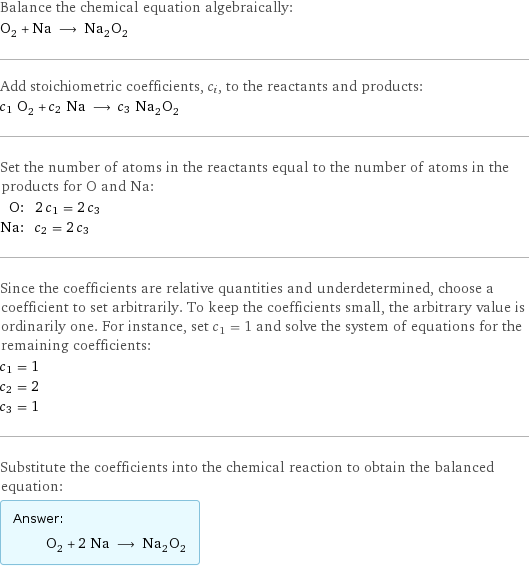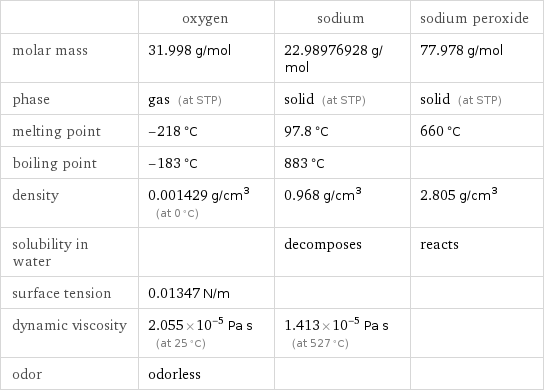Input interpretation

O_2 (oxygen) + Na (sodium) ⟶ Na_2O_2 (sodium peroxide)
Balanced equation

Balance the chemical equation algebraically: O_2 + Na ⟶ Na_2O_2 Add stoichiometric coefficients, c_i, to the reactants and products: c_1 O_2 + c_2 Na ⟶ c_3 Na_2O_2 Set the number of atoms in the reactants equal to the number of atoms in the products for O and Na: O: | 2 c_1 = 2 c_3 Na: | c_2 = 2 c_3 Since the coefficients are relative quantities and underdetermined, choose a coefficient to set arbitrarily. To keep the coefficients small, the arbitrary value is ordinarily one. For instance, set c_1 = 1 and solve the system of equations for the remaining coefficients: c_1 = 1 c_2 = 2 c_3 = 1 Substitute the coefficients into the chemical reaction to obtain the balanced equation: Answer: | | O_2 + 2 Na ⟶ Na_2O_2
Structures

+ ⟶
Names

oxygen + sodium ⟶ sodium peroxide
Reaction thermodynamics
Enthalpy

| oxygen | sodium | sodium peroxide molecular enthalpy | 0 kJ/mol | 0 kJ/mol | -510.9 kJ/mol total enthalpy | 0 kJ/mol | 0 kJ/mol | -510.9 kJ/mol | H_initial = 0 kJ/mol | | H_final = -510.9 kJ/mol ΔH_rxn^0 | -510.9 kJ/mol - 0 kJ/mol = -510.9 kJ/mol (exothermic) | |
Entropy

| oxygen | sodium | sodium peroxide molecular entropy | 205 J/(mol K) | 51 J/(mol K) | 95 J/(mol K) total entropy | 205 J/(mol K) | 102 J/(mol K) | 95 J/(mol K) | S_initial = 307 J/(mol K) | | S_final = 95 J/(mol K) ΔS_rxn^0 | 95 J/(mol K) - 307 J/(mol K) = -212 J/(mol K) (exoentropic) | |
Equilibrium constant
![Construct the equilibrium constant, K, expression for: O_2 + Na ⟶ Na_2O_2 Plan: • Balance the chemical equation. • Determine the stoichiometric numbers. • Assemble the activity expression for each chemical species. • Use the activity expressions to build the equilibrium constant expression. Write the balanced chemical equation: O_2 + 2 Na ⟶ Na_2O_2 Assign stoichiometric numbers, ν_i, using the stoichiometric coefficients, c_i, from the balanced chemical equation in the following manner: ν_i = -c_i for reactants and ν_i = c_i for products: chemical species | c_i | ν_i O_2 | 1 | -1 Na | 2 | -2 Na_2O_2 | 1 | 1 Assemble the activity expressions accounting for the state of matter and ν_i: chemical species | c_i | ν_i | activity expression O_2 | 1 | -1 | ([O2])^(-1) Na | 2 | -2 | ([Na])^(-2) Na_2O_2 | 1 | 1 | [Na2O2] The equilibrium constant symbol in the concentration basis is: K_c Mulitply the activity expressions to arrive at the K_c expression: Answer: | | K_c = ([O2])^(-1) ([Na])^(-2) [Na2O2] = ([Na2O2])/([O2] ([Na])^2)](../image_source/f7b5c3aa40ed7c1d7ecb3803a12fc363.png)
Construct the equilibrium constant, K, expression for: O_2 + Na ⟶ Na_2O_2 Plan: • Balance the chemical equation. • Determine the stoichiometric numbers. • Assemble the activity expression for each chemical species. • Use the activity expressions to build the equilibrium constant expression. Write the balanced chemical equation: O_2 + 2 Na ⟶ Na_2O_2 Assign stoichiometric numbers, ν_i, using the stoichiometric coefficients, c_i, from the balanced chemical equation in the following manner: ν_i = -c_i for reactants and ν_i = c_i for products: chemical species | c_i | ν_i O_2 | 1 | -1 Na | 2 | -2 Na_2O_2 | 1 | 1 Assemble the activity expressions accounting for the state of matter and ν_i: chemical species | c_i | ν_i | activity expression O_2 | 1 | -1 | ([O2])^(-1) Na | 2 | -2 | ([Na])^(-2) Na_2O_2 | 1 | 1 | [Na2O2] The equilibrium constant symbol in the concentration basis is: K_c Mulitply the activity expressions to arrive at the K_c expression: Answer: | | K_c = ([O2])^(-1) ([Na])^(-2) [Na2O2] = ([Na2O2])/([O2] ([Na])^2)
Rate of reaction
![Construct the rate of reaction expression for: O_2 + Na ⟶ Na_2O_2 Plan: • Balance the chemical equation. • Determine the stoichiometric numbers. • Assemble the rate term for each chemical species. • Write the rate of reaction expression. Write the balanced chemical equation: O_2 + 2 Na ⟶ Na_2O_2 Assign stoichiometric numbers, ν_i, using the stoichiometric coefficients, c_i, from the balanced chemical equation in the following manner: ν_i = -c_i for reactants and ν_i = c_i for products: chemical species | c_i | ν_i O_2 | 1 | -1 Na | 2 | -2 Na_2O_2 | 1 | 1 The rate term for each chemical species, B_i, is 1/ν_i(Δ[B_i])/(Δt) where [B_i] is the amount concentration and t is time: chemical species | c_i | ν_i | rate term O_2 | 1 | -1 | -(Δ[O2])/(Δt) Na | 2 | -2 | -1/2 (Δ[Na])/(Δt) Na_2O_2 | 1 | 1 | (Δ[Na2O2])/(Δt) (for infinitesimal rate of change, replace Δ with d) Set the rate terms equal to each other to arrive at the rate expression: Answer: | | rate = -(Δ[O2])/(Δt) = -1/2 (Δ[Na])/(Δt) = (Δ[Na2O2])/(Δt) (assuming constant volume and no accumulation of intermediates or side products)](../image_source/564188e02b8c03ef651a56963a210f23.png)
Construct the rate of reaction expression for: O_2 + Na ⟶ Na_2O_2 Plan: • Balance the chemical equation. • Determine the stoichiometric numbers. • Assemble the rate term for each chemical species. • Write the rate of reaction expression. Write the balanced chemical equation: O_2 + 2 Na ⟶ Na_2O_2 Assign stoichiometric numbers, ν_i, using the stoichiometric coefficients, c_i, from the balanced chemical equation in the following manner: ν_i = -c_i for reactants and ν_i = c_i for products: chemical species | c_i | ν_i O_2 | 1 | -1 Na | 2 | -2 Na_2O_2 | 1 | 1 The rate term for each chemical species, B_i, is 1/ν_i(Δ[B_i])/(Δt) where [B_i] is the amount concentration and t is time: chemical species | c_i | ν_i | rate term O_2 | 1 | -1 | -(Δ[O2])/(Δt) Na | 2 | -2 | -1/2 (Δ[Na])/(Δt) Na_2O_2 | 1 | 1 | (Δ[Na2O2])/(Δt) (for infinitesimal rate of change, replace Δ with d) Set the rate terms equal to each other to arrive at the rate expression: Answer: | | rate = -(Δ[O2])/(Δt) = -1/2 (Δ[Na])/(Δt) = (Δ[Na2O2])/(Δt) (assuming constant volume and no accumulation of intermediates or side products)
Chemical names and formulas

| oxygen | sodium | sodium peroxide formula | O_2 | Na | Na_2O_2 name | oxygen | sodium | sodium peroxide IUPAC name | molecular oxygen | sodium | disodium peroxide
Substance properties

| oxygen | sodium | sodium peroxide molar mass | 31.998 g/mol | 22.98976928 g/mol | 77.978 g/mol phase | gas (at STP) | solid (at STP) | solid (at STP) melting point | -218 °C | 97.8 °C | 660 °C boiling point | -183 °C | 883 °C | density | 0.001429 g/cm^3 (at 0 °C) | 0.968 g/cm^3 | 2.805 g/cm^3 solubility in water | | decomposes | reacts surface tension | 0.01347 N/m | | dynamic viscosity | 2.055×10^-5 Pa s (at 25 °C) | 1.413×10^-5 Pa s (at 527 °C) | odor | odorless | |
Units
